Sample Images from Ten Digital Camcorders
Below are several images from different digital video cameras: the Sony TR7000 and
TRV120 Digital 8, Sony TRV10, TRV900, VX2000 and Panasonic MX3000, DVX100 MiniDV, and
Canon Elura, Elura 2mc, and GL1 MiniDV.
Some of these cameras can use separate solid-state memory devices for stills,
but all these images are all full-frame (2 field) captures from normal (interlaced) video
from tape playback, except I also have the DVX100 in progressive (full-frame, noninterlaced) mode.
The cat image is a 300x250 pixel detail cropped from the full 720x480 DV frame
captured via firewire from each camera, and saved as JPEG from Photoshop
(Quality 8). The resolution test pattern also a detail cropped from the full pattern in each case. The full screen and
detail area is shown below at lower resolution but the proper 4:3 aspect
ratio.


Cameras were in auto-exposure, auto-focus, and auto white balance. Nothing
has been adjusted and no filters were applied. The images below show the
original pixels which means the aspect ratio on a computer display is 1.5:1
instead of proper 1.33:1 as it would be on a TV. Normally, you also need to
change the gamma setting for proper computer display. You can see detail
differences in the center cat's wiskers, among other things.
The setting is indoors, with light from a 500W halogen fixture. In the case
of the Digital 8 cameras you see a false yellow color on the whiskers and the
resolution pattern. The color is better under natural lighting
(sunlight). The TRV10 also has some false color on the line pattern, which
I did not see at all in sunlight. The yellow cast of the TRV900 in this
light can be corrected by manual white balancing which I did not do. Movie
film also records these halogens as being yellow, rather than white.
Images from all the cameras look lighter and lower contrast (washed-out)
when viewed on a computer monitor, relative to the same image displayed
on a TV or NTSC video monitor.
Sony TR7000 f/1.7 1/60sec


Sony TRV120 f/1.6 1/100sec

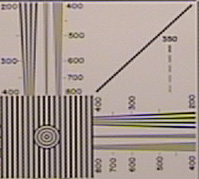
Sony TRV10 f/2.4 1/60sec

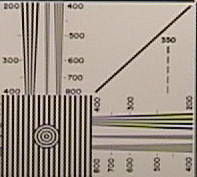
Panasonic NV-MX3000 f/2.4 1/60sec

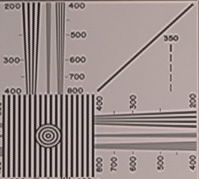
Canon Elura f/2.8 1/60sec


Canon Elura 2mc f/1.8 1/120sec

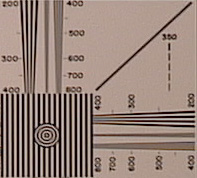
Canon GL1 f/3.4 1/60sec

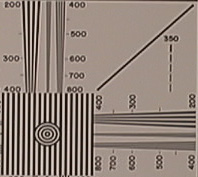
Sony TRV900 f/4.0 1/60sec


Sony VX2000 f/5.6 1/60sec

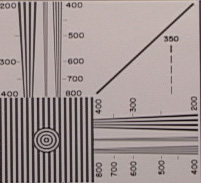
Panasonic AG-DVX100 f/6.8 1/60sec

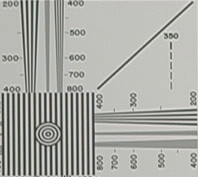
Panasonic AG-DVX100 f/4.8 1/48sec 24p (progressive-scan)

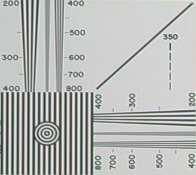
The DVX100 in 24p mode used "cine-like gamma" and "cine-like color matrix" which appears to give more color saturation
than the "normal" mode. There is a separate chroma level control, which was left at the default (midpoint) in both interlaced and prog-scan modes.
The horizontal wedges show the increased resolution in prog-scan mode.
Canon EOS-D30 (d-SLR) f/4.5 1/60sec (ISO 400)

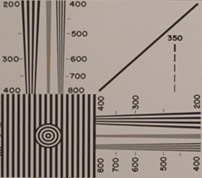
As an experiment, I took the same shots with a still camera, the Canon D30 (3-Mpixel digital SLR, set at ISO 400)
and then rescaled the image in Photoshop to the 0.9 pixel aspect, 720x480 bitmap of a DV frame so it compares
directly with the video cameras. I used the D30 in auto-white balance.
Note how the black cat's eyes change color; the D30 tends to exaggerate blue.
Sensitivity
The cats are part of a poster (Cats No. 1530, (C)
1997 Western Graphics Corporation, Eugene, OR). It is illuminated via
diffused halogen light. The lighting conditions were the same for all
cameras tested. The incident exposure reading at the center of the picture
is EV 8.1 or 690 Lux. The spotmeter reading on the white cat's forehead is
EV 10.1 and the black cat's forehead, EV 6.6. I used a Sekonic L-508 light
meter in incident and 1-degree spot modes to measure this. On the cameras,
autoexposure, auto-focus and image stabilization was used in all cases except the DVX100.
When framing the cats poster in auto-exposure mode, the cameras chose the
following settings: TR7000: f/1.7, TRV120 f/1.6 (1/100s),
TRV10: f/2.4, MX3000: f/2.4,
Elura: f/2.8, Elura 2mc:f/1.8 (1/120 sec),
GL1: f/3.4, TRV900: f/4.0, VX2000: F/5.6.
Based on f/stop readings with the same scene and lighting, the AG-DVX100 is the most sensitive and the
Digital 8s are the least sensitive.
Note that the Elura 2mc and the TRV120, which use digital image stabilization,
default to 1/100 or 1/120 sec exposure (unless you switch stabilization off).
The DVX100 is one stop less sensitive in prog.scan mode, than interlaced mode (same is true of the
Sony TRV900 and VX2000, although since those cameras only do 15 fps progressive it is not so useful
for motion video.)
The Canon GL1 and Sony VX2000 have an adjustable "sharpness" control, which was
at its default (center) position when taking these frames. The range of the controls
is different; for any reasonable setting, the GL1 image is always more "sharpened"
appearing than the VX2000. The DVX100 "detail" setting was at -4 to better match the VX2000.
Many thanks to Scott C. for dropping by with
his Elura, Ed E. with his MX3k, and Ryan K. for the loan of the TRV10.
There is a large collection of DV camera resolution test frames here.
See also: Analog Copy Resolution
test page for image quality comparisons for DV, Analog, SVHS and VHS tape transfers.
See also: Color Resolution for the shocking truth
about DV resolution on saturated colors.
Back to TRV900 page.



























